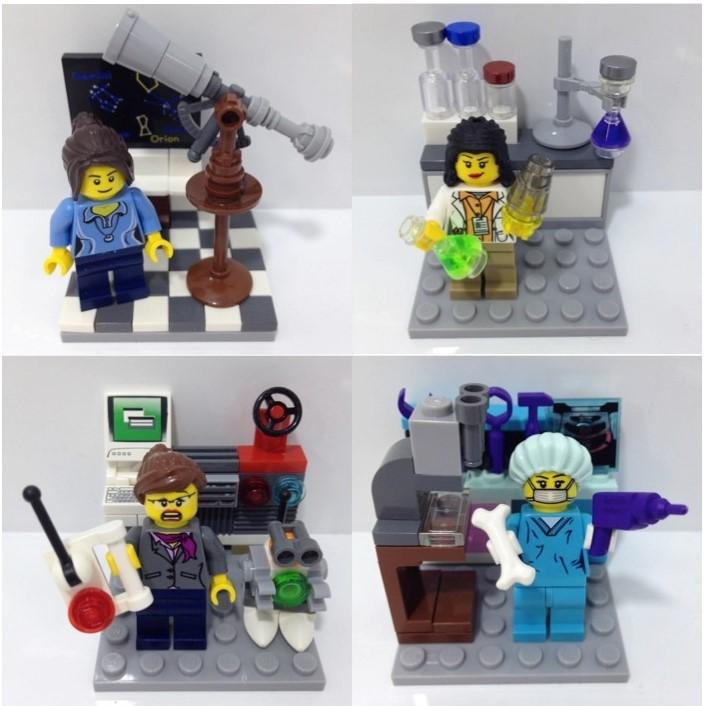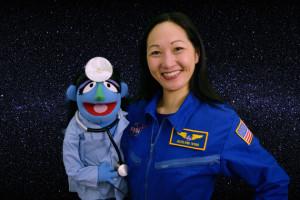On the 30th Anniversary of the Challenger Disaster, Four Women in Science Honor the Legacy of the Crew
Thirty years ago today, the Space Shuttle Challenger lifted off from Cape Canaveral, Florida. 73 seconds later, it broke apart in midair, leading to the deaths of all seven of its crew members. One of those crew members was Christa McAuliffe, who had been selected as part of the “Teacher in Space Project,” a NASA program that would send teachers into space as payload specialists on certain Space Shuttle missions. McAuliffe planned to teach two lessons to her students from aboard the Challenger, then return to the classroom after the mission to discuss her experience.
The program was conceived by President Ronald Reagan to encourage student interest in space exploration, science, and math. McAuliffe was the first teacher to participate in the program, and also the last: the program was canceled after her death on the Challenger.
On the morning of the Challenger liftoff, thousands of students watched from their classrooms as the shuttle lifted off and then disintegrated over the Atlantic Ocean. One of those students was Julielynn Wong, who would, years later, attend Harvard University before receiving her Doctor of Medicine from Queen’s University in Ontario. Since then, she has won multiple awards for her work in technology-based healthcare and founded 3D4MD, a company dedicated to 3D printing medical supplies for people in remote locations.
Thirty years after watching the Challenger explode, Dr. Wong and three other female scientists are honoring McAuliffe and the other crew members killed on the shuttle by participating in a simulated mission at NASA’s Johnson Space Center. On January 25, Dr. Wong, aerospace engineer Michelle Courtney, NASA scientist LaShelle Spencer, and mechanical engineer and roboticist Leah Honey moved into the Human Exploration Research Analog (HERA). Formerly known as the Deep Space Habitat, HERA is a three-story module that simulates the conditions of an actual space flight. The module was designed, originally, for engineering demonstrations; NASA is now using it to study the effects of space flight on the human body and psyche, as well as to address potential problems and risks for future missions.
The team will live in the HERA module for thirty days to simulate the “flight conditions and isolation associated with a mission to a near-Earth asteroid,” according to Dr. Wong. She is serving as the mission’s flight engineer, while Courtney is flight commander, Spencer is first mission specialist, and Honey is second mission specialist.
One of those educational outreach activities will involve a group of fifth graders taking a field trip to the Challenger Learning Center in Tallahassee, Florida. The learning center is one of more than 40 that were established following the Challenger tragedy as a way to honor the memories of the crew. The students visiting the center will participate in their own simulated mission to intercept a comet, and they will teleconference with Dr. Wong during their mission.“Every mission day is carefully planned out, with a busy schedule similar to a day on the International Space Station,” says Dr. Wong. “A typical day will include meals, exercise, planning meetings, scientific research, simulated mission operations, training drills, and housekeeping. We chat with our family and friends once a week and participate in education and public outreach activities.”
“After my HERA mission, I will be conducting an experiment to 3D print the first medical tools on the International Space Station,” notes Dr. Wong.
The HERA IX mission, coinciding with the anniversary of the Challenger explosion, particularly honors the mission of McAuliffe, which was to educate and inspire children – particularly girls. While she may not have said it, the mere fact that she was a woman going into space set her apart as a role model for women and girls, who have been told again and again that they’re not smart enough or not “naturally equipped” for careers in science and math. Progress has been made in the 30 years since McAuliffe’s death, but it’s a slow progress, like slogging through mud. Since space travel began, well over 500 people have gone into space, but only 58 of them have been women.
The attitude towards women in science goes well beyond space exploration, and it’s pervasive. Remember Sir Tim Hunt? The Nobel Prize-winning scientist commented last year about the ineffectiveness of women in the lab, calling them too emotional and too distracting. His comments were met with derision by female scientists, many of whom mocked him on Twitter by posting pictures of themselves at work with the #distractinglysexy tag. Hunt would later resign, but he’s far from being alone in his attitude. Women in scientific and technical fields face pressure beyond ordinary job stress. There are the sexist comments, the focus on their appearances rather than their work, and the knowledge that any errors will likely be chalked up to their being women, rather than their being human.

Julielynn Wong created a Lego tribute to the HERA IX crew. Clockwise from top left: Michelle Courtney, LaShelle Spencer, Julielynn Wong, Leah Honey.
While there’s plenty to discourage girls and women from pursuing scientific careers, even well-meaning efforts to encourage them can be patronizing. Just this week we published an article on “pinkifying,” or dressing up tech with extra “girly” elements in a misguided belief that females will be more attracted to technology if it’s prettied up for them. One example is the “hack a hairdryer” campaign by IBM, which invited women to “reengineer misconceptions about women in tech, and to focus on what really matters in science” – which, apparently, was creating better hairdryers. Unsurprisingly, there was quite a bit of backlash against this as well.
Conversely, the backlash stirred by misguided comments like those from Hunt and IBM may actually serve as a motivator for females considering scientific careers. The overwhelming response from women working in science in tech is that despite prejudice that has lasted for far too long, we’re going to go about our work anyway.
 With technology advancing at its current rate, we’re going to see a lot more people going into space than ever before, and hopefully the gap between men and women in space will begin to close. Coincidentally, Hera is the Greek goddess of women, which inspired the design of the HERA IX badge, which was made to look like a peacock feather – Hera’s symbol. The names of the four female crew members are on the badge along side seven stars representing the seven Challenger crew members. If you want to attract girls to science using imagery, that’s a pretty good start – much better than pink and glitter. When the fifth-grade field trip participants speak with Dr. Wong during their respective simulated missions, they will learn a lot about space travel – and hopefully they will see Dr. Wong and her fellow female crew members as the “norm” rather than the exception. Christa McAuliffe would be proud. Discuss your thoughts on this honor of the shuttle in the Challenger Honored 30 Years Later forum over at 3DPB.com.
With technology advancing at its current rate, we’re going to see a lot more people going into space than ever before, and hopefully the gap between men and women in space will begin to close. Coincidentally, Hera is the Greek goddess of women, which inspired the design of the HERA IX badge, which was made to look like a peacock feather – Hera’s symbol. The names of the four female crew members are on the badge along side seven stars representing the seven Challenger crew members. If you want to attract girls to science using imagery, that’s a pretty good start – much better than pink and glitter. When the fifth-grade field trip participants speak with Dr. Wong during their respective simulated missions, they will learn a lot about space travel – and hopefully they will see Dr. Wong and her fellow female crew members as the “norm” rather than the exception. Christa McAuliffe would be proud. Discuss your thoughts on this honor of the shuttle in the Challenger Honored 30 Years Later forum over at 3DPB.com.
Subscribe to Our Email Newsletter
Stay up-to-date on all the latest news from the 3D printing industry and receive information and offers from third party vendors.
You May Also Like
3D Printing Unpeeled: New Arkema Material for HP, Saddle and Macro MEMS
A new Arkema material for MJF is said to reduce costs per part by up to 25% and have an 85% reusability ratio. HP 3D HR PA 12 S has been...
3D Printing News Briefs, January 20, 2024: FDM, LPBF, Underwater 3D Printer, Racing, & More
We’re starting off with a process certification in today’s 3D Printing News Briefs, and then moving on to research about solute trapping, laser powder bed fusion, and then moving on...
3D Printing Webinar and Event Roundup: December 3, 2023
We’ve got plenty of events and webinars coming up for you this week! Quickparts is having a Manufacturing Roadshow, America Makes is holding a Member Town Hall, Stratafest makes two...
Formnext 2023 Day Three: Slam Dunk
I’m high—high on trade show. I’ve met numerous new faces and reconnected with old friends, creating an absolutely wonderful atmosphere. The excitement is palpable over several emerging developments. The high...


































